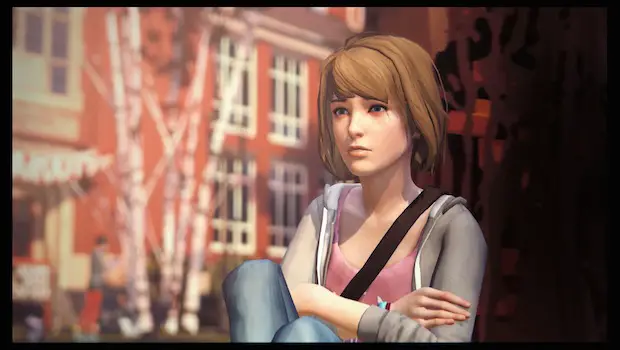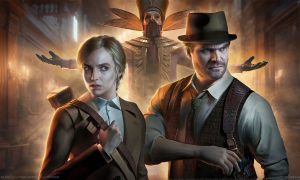When observing a portrait of her hometown inside her friend’s house, Life is Strange’s protagonist Max internalizes a Thomas Wolfe quote: “You can’t go home again.” In a game littered with artistic references ranging from John Lennon to Salvador Dali, I brushed it off as another hipster-reference meant to characterize her as a well-read individual.
As I progressed, however, the line stuck with me. You can’t go home again. There is no return to what was once safe, sound and normal. In a game as narratively driven as Life is Strange, it was a good fit.
The game opens with Max, an 18-year-old girl attending the prestigious Blackwell Academy. An upper-class high school that happens to house a world-class photographer, the aspiring photo junkie Max has returned here to develop her visual talents and rekindle her attempt at a normal high-school life.
While on a journey for bathroom solace, something that will be familiar to anyone who has been a teen before, Max sees Nathan, a fellow student, shoot and kill a blue-haired girl after a drawn-out argument over drugs and money.
Reaching out to the student to intervene, Max realizes she can reverse time. She starts out only using this power for her own benefit, but soon begins to realize that there might be greater intentions for her powers in the future.

Blackwell Academy is the heart of Arcadia Bay, a private school for gifted high schoolers.
Nothing’s gonna change my world / Nothing’s gonna change my world – Across the Universe by The Beatles
Life is Strange draws inspiration, in many ways, from the style of game Telltale has become infamous for. Narratively driven, focused on characters and their interactions, with occasional bouts of puzzle solving. So it seems strange, then, that a game that demands choice of you would give you a simple method to rewind and rewrite any decision you make.
It is in that ability, though, that the game subverts you and makes choices that much more difficult. You can rewind to answer questions with new facts; for example, I couldn’t remember a character’s last name, so I answered wrong purposefully to learn it, then rewind time and use that leverage to endear her to me and get the information I needed.

A heated decision, and even if you rewind, you’ll find yourself questioning which outcome is really better.
You can also rewind major decisions, electing to make a different one entirely. In the example of the gunman, after I stopped the shooting, I could choose to either inform the principal or keep quiet. If I told, I would be incriminating Nathan Prescott, the son of Blackwell’s greatest financial supporter, to the man who most cared about checks floating into the school. But if I didn’t, then I might be endangering other students who could get hurt if Nathan flew off the handle again.
In puzzle solving, the time rewind is a simplistic mechanic, where you find the variable and adjust it at the proper point in the timeline for a desired effect. In the story, however, it was a heavy burden. The option to re-do did not diminish my choices, but add weight to them. It was like the game asked me, after every major plot point, “are you sure?” And continuing on meant settling with my choices. I couldn’t brush them off as heat-of-the-moment decisions, they were something I had to live with, knowing every possible outcome.

Text messaging that isn’t awkward, and even funny at times.
We see the world through the lens of all our experiences; that is the fundamental part of the human condition. – Madeleine M. Kunin
Many mediums often struggle to represent teen culture accurately. Since teen culture is often counter-culture by nature, previous generations struggle and abhor what they don’t understand. Life is Strange manages to strike a middle line, sometimes veering into “out-of-touch” mannerisms, but still having characters that feel genuine.
The standouts are easily Max and Chloe, the main protagonists. Two girls who spent their childhood together, split when Max’s family moved away, their relationship is jagged and familiar in the way that it would be in real life. There’s a sense of hostility in the distance they shared, the phone calls that didn’t happen, and the major life events missed, and voice actors Hannah Telle and Ashly Burch play Max and Chloe’s rekindled friendship perfectly.
The main plotline of the game revolves around the two protagonist’s respective dilemmas. Max keeps seeing visions of a tornado ripping into Arcadia Bay, destroying everything, and she struggles to understand why she can suddenly control time. Chloe’s friend Rachel has been missing for some time, and her disappearance is highly suspect, yet many residents of Arcadia Bay seem to have moved on suspiciously fast.

The contrast between Chloe and Max, and their tepid relationship, is fascinating to play out.
Used to be one of the rotten ones and I liked you for that / Now you’re all gone, got your makeup on and you’re not coming back – Anthems for a Seventeen Year Old, by Broken Social Scene
Intrigue keeps you gripped, but the moment-to-moment conflicts in the game are extremely grounded. There’s an altercation between Chloe and her militaristic step-dad, whose good intentions are masked by his brutish approach to parenting. Victoria, the resident mean girl, can sometimes have a heart of gold. But why is she taking down Rachel’s missing posters all around campus? Kate is a good Christian girl who is berated and picked on, yet you later stumble on her being told she “needs to pick a side…”

The journal provides backstory in a very natural way.
To contrast this depth, however, the dialogue is often hit-or-miss. The pervasive use of “hella,” “selfie,” and other colloquial terms reminds me of the way older people think young people talk a certain way. It’s rarely used in excess, but the slang and name-dropping of artists and B-movie cult classics does tire, though it seems confined to only a section of the game. It did make me reflect a bit on my own teenage years and remember similar idioms and sense of trying to be smart and on the cutting edge, but to others, that may be a turn-off.
Life is Strange has many genuine elements of teenage nostalgia, though, the kind of problems you only have when you have too few responsibilities and too much time on your hands. And through all the fights between roomies and boy troubles, there’s always a lingering sense of dread, as if something much more sinister is lurking beneath the surface. It’s the same atmosphere that games like Gone Home have crafted in the past, and it will keep you gripped all the way till the end credits of episode 1.

The scribbles and stains of the journal make for a believable keepsake.
Look and think before opening the shutter. The heart and mind are the true lens of the camera. – Yousuf Karsh
Many games have tried and failed at the artistic approach to graphics, often appearing low-res, un-rendered or jaggy. Yet the odd painterly-aesthetic, combined with the teenage scribbles and journal entries, create a cohesive universe.
Text messages display in a tilted layout, and Max’s journal serves as both a source of learning her story prior to the game’s opening, and a colorful recap of events that have transpired throughout your playtime.
Developers Dontnod also added a bit of flavor with several tracks of licensed music. While there’s plenty of ambient sounds and pieces that play, the opening track that plays as Max walks the halls of Blackwall, blocking out the world with a white pair of earbuds still sticks out in my mind. It felt oddly nostalgic, seeing an introduction to high school life that wasn’t as caricatured as the American Pie’s of the world.

Every character’s room is adorned with punk rock posters and quotes from artists.
I think all art is about control – the encounter between control and the uncontrollable. – Richard Avedon
Life is Strange is a special experience, one that has stuck with me more than most episodic games do. Though it is only episode one, I am already impressed with the strides Dontnod has taken with their rewind mechanics, and the quality of storytelling they’ve crafted around it. This is a rainy day game, the kind that you put on and play through, completely enthralled in the story and atmosphere.
When the credits roll, you’ll sit there contemplating what’s yet to come, and yet have that beautiful feeling that signifies the start of something special. It may only be getting started, but I have high hopes for a game that is daring to take chances in ways I haven’t seen games do so before.

The painterly style is initially strange, but well-done and consistent. The trees especially look amazing.
If Chrysalis lives up to its namesake, preparing a beautifully-woven cocoon for the rest of the series to metamorphose out of, gamers have something to look forward to. Life is Strange has one of the best debuts I’ve seen from an episodic series, and we can look forward to seeing if it follows up strong on its promises in March 2015.
I'm a Texas native and graduate of Texas Tech University, freelancing in the gaming journalism industry. I love games, live music, Texas BBQ and sports. Favorite games are The Witcher 2, anything from Bioware, the Kingdom Hearts series and Dota 2.


 Buy Now
Buy Now
 Buy Now
Buy Now
 Buy Now
Buy Now
 Buy Now
Buy Now
 Buy Now
Buy Now
 Buy Now
Buy Now















